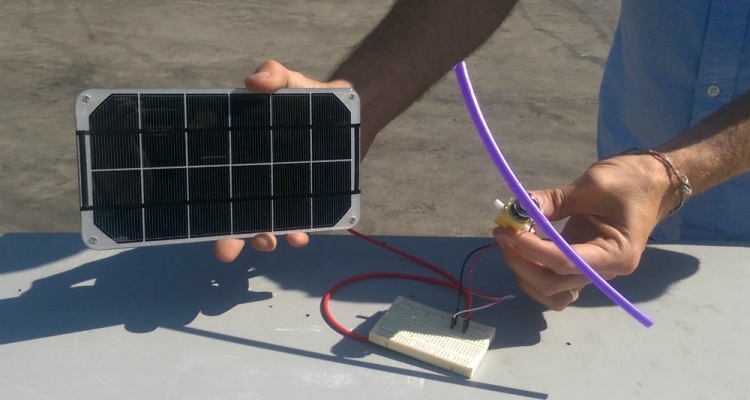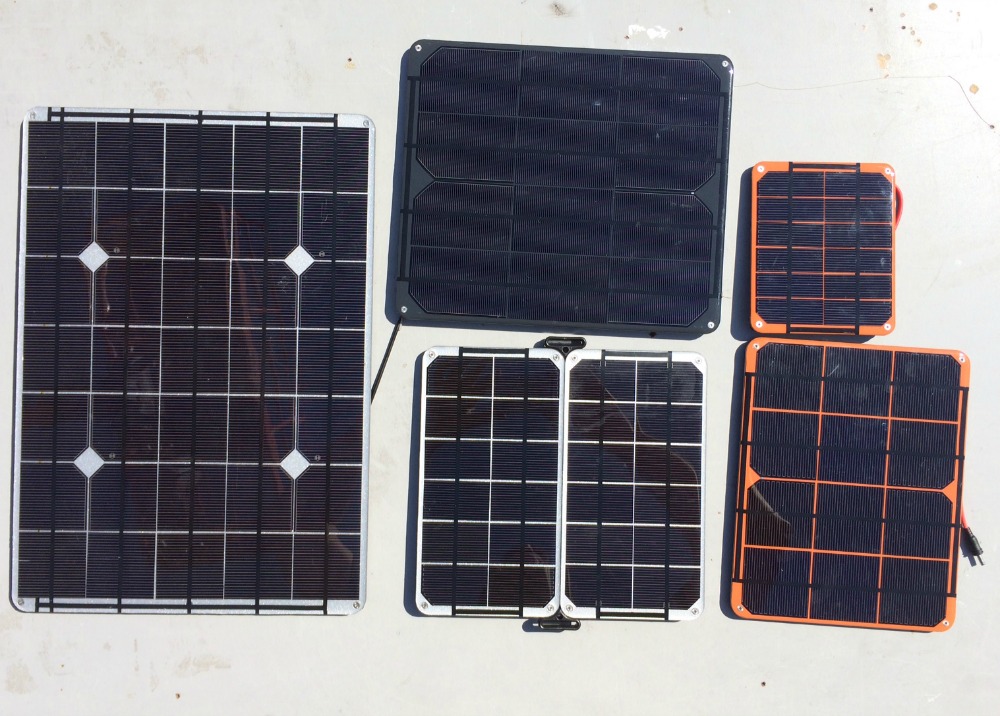Solar Panels for Small Motors
In this guide we look at the options you have when deciding on solar panels for small motors starting with how to begin select the right panel for your motor. In general, we found to get the best performance to cost/size ratio when the voltage of the panel slightly exceeded the voltage rating of the motor and a peak current 25-50% higher than the max current of the motor.
Please repeat the tests for your projects and let us know what you find.
We experimented with four simple motors:
- DC Toy Hobby Motor (4.5 – 9V, 0.25A)
- HSD-8025 Brushless DC Cooling Fan (12V/ 0.12A)
- DAGU robot DG01D Mini DC Gear Box (4.5V, .25A)
- Liquid Pump – 350GPH (12V, 1.5A)
And we used a suite of panels for testing including: 2 Watt, 6 Volt / 3.5 Watt, 6 Volt x 2 (paired in series to get 12V) / 6 Watt, 6 Volt / 9 Watt, 6 Volt / 9 Watt, 18 Volt / 17 Watt, 18 Volt panel.
Making the Connection
You can simply twist the positive and negative leads from the solar panel to the motor. We recommend using our 1 Foot Extension so you don’t have to hack our cable.
To make things easier to swap panels and take measurements, we wired each of the small motors and our extension cable with exposed leads to jumper wires.
This DAGU Motor already had jumper wires.
Basic Behavior
When a panel isn’t connected to anything, it has a relatively high voltage and zero current. Our 2 Watt, 6 Volt panel has an open circuit voltage a bit over 7V. As soon as you connect to the motor the voltage drops and, if you meet the minimum threshold of the motor, current flows and the motor spins.
In this video, you will see motor speed up when pointed directly at the sun and slow down when panel is angled away from the sun or shaded.
2 Watt, 6 Volt Panel Results
With a 2 Watt, 6 Volt panel and less than ideal conditions, the motor spins, but the motor draws less voltage and current than its’ specification. In good conditions, the voltage and current climb slightly above the spec of 0.25A and the total power through the motor is about 3/4 of the rated specification of the panel. When we connect to a larger 6 Watt panel, the motor reaches a maximum current of 0.43 Amps, well above the spec of the motor and less than half the rated output of the 6 Watt Panel. Our 2 Watt or 3.5 Watt panel seems like the best fit if you are expecting reasonably good conditions.
| Panel | Position | Volts | Current | Watts | Action |
|---|---|---|---|---|---|
| 2 Watt | 180 Away | 1.0 | 0.05 | 0.05 | Very slow |
| 2 Watt | 45 Away | 3.5 | 0.2 | 0.7 | Medium Fast |
| 2 Watt | Pointed At Sun | 5.2 | 0.30 | 1.56 | Fast |
| 6 Watt | 45 Away | 6.2 | 0.43 | 2.67 | Fast |
| 6 Watt | Pointed At Sun | 6.5 | 0.43 | 2.80 | Fast |
DAGU DG01D Results
We see similar behavior with the DAGU DG01D, but it has more resistance than the toy motor and needs more power to reach its max. A 2 Watt panel can get it turning, but it is too small to get much speed going and we’re only able to get about 30% rated power from the panel. In this case, we’re exceeding the rated current with a 6 Watt panel in perfect conditions, but in imperfect conditions, we are able to make the motor move consistently. We’re also getting 75% of the rated power into the motor. Bumping up to 9 Watts, it is easy to exceed the max current specification of the motor in a range of conditions.
| Panel | Position | Volts | Current | Watts | Action |
|---|---|---|---|---|---|
| 2 Watt | 180 Away | 0.6 | 0.1 | 0.06 | Very Slow |
| 2 Watt | 45 Away | 1.37 | 0.2 | 0.27 | Slow |
| 2 Watt | Pointed At Sun | 2.0 | 0.32 | 0.64 | Medium |
| 6 Watt | 45 Away | 3.7 | 0.54 | 2.0 | Fast |
| 6 Watt | Pointed At Sun | 5.7 | 0.8 | 4.56 | Fast |
| 9 Watt | 45 Away | 6.0 | 0.8 | 4.8 | Fast |
| 9 Watt | Pointed At Sun | 6.3 | 0.8 | 5.0 | Fast |
Low Voltage Kills Power
We tested also tested a 12V motor, 0.1A motor with 2 x 6V panels in series and parallel (6V and 12V). With the lower voltage setup, the voltage, current and total power output were less than with the panels in series, the power output increased by about 4X. The lesson is that if the panel is well below the rated spec of the motor, it may spin, but you will be wasting a lot of power.
| Panel | Position | Volts | Current | Watts |
|---|---|---|---|---|
| 7 Watt / 6V | 45 Away | 5.9 | 0.09 | 0.53 |
| 7 Watt / 6V | Pointed At Sun | 6.12 | 0.1 | 0.61 |
| 7 Watt / 12V | 45 Away | 12.0 | 0.17 | 2.04 |
| 7 Watt / 12V | Pointed At Sun | 12.7 | 0.18 | 2.29 |
Real Work – Doubling Power on a Pump
If you are below the rating of a motor or pump, increasing the amount of solar power, will increase the power through the motor. As a quick example, we connected a single 17 Watt panel up to a water pump and it moved water pretty quickly out of the bucket through a 3/4 “ hose. However, that panel outputs 1A max, below the maximum rating of the pump. Adding a second panel increases the current and voltage and increases the through put of the motor.






Hello,
trust you are well.
I recently got my sons some RC toys, they running on lipo batteries about 7.4V. I am wondering if it would be possible to use your panels to power them up!
Please revert
Rgds
It is possible. Easiest way would be to connect a balance charger to our V88 battery pack included in the Arc 20 Watt Kit. Many balance chargers have a DC input like this one: https://www.amazon.com/GoolRC-Professional-Balance-Charger-Discharger/dp/B01HXHGARY
We haven’t tested going directly from a solar panel into a balance charger.